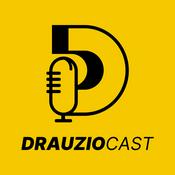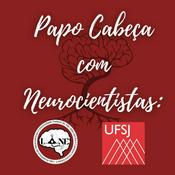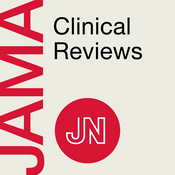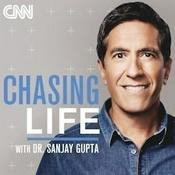117 episódios

Unusual emboli, and software versus hardware - Case Reports December 2025
16/12/2025 | 41min
Another set of intriguing cases from the latest issue of the journal, pored over by the Case Reports team. In the first case, a 24-yo man presents acutely with reduced consciousness, following 3 days of right-sided headache. His mother reports sudden behavioural changes with jerky movements and enlarged pupils. He is agitated, not obeying commands and not moving his left-side limbs. He had a history of autism and vascular Ehlers-Danlos syndrome and was on medication for stroke prevention. An MRI scan led to a differential diagnosis of Posterior Reversible Encephalopathy Syndrome (PRES), but the final conclusion came post-discharge after a further review of his scans. https://pn.bmj.com/content/25/6/549 The second report (19:37) describes two curious instances of functional neurological disorder (FND), both of which improved after the patients were in comatose states. The first patient is a 59-yo man who had developed muscle weakness shortly after at car crash at age 49, and had subsequently been reliant on a wheelchair for more than 8 years. Recently the patient had been infected simultaneously with severe cases of flu and COVID-19, during which he had been sedated and placed in an induced coma for several weeks. Awakening from the coma, the patient showed surprising signs of new mobility. In the second patient, a 40-yo woman presented with flaccid paralysis of her left arm, with loss of sensation up to the shoulder. She had a history of bipolar disorder and agoraphobia. She was diagnosed with FND and participated in physiotherapy and hypnotherapy with no improvement. Thirteen months later she was readmitted following an overdose on a mix of analgesics and sedatives, and was ventilated in the ITU for several hours. Upon waking the patient noticed that her previously paralyzed arm had completely recovered. https://pn.bmj.com/content/25/6/562 Further reading: Advances in functional Neurological disorder (BMJ Neurology Open) The case reports discussion is hosted by Prof. Martin Turner¹, who is joined by Dr. Ruth Wood² and Dr. Babak Soleimani³ for a group examination of the features of each presentation, followed by a step-by-step walkthrough of how the diagnosis was made. These case reports and many others can be found in the October 2025 issue of the journal. (1) Professor of Clinical Neurology and Neuroscience at the Nuffield Department of Clinical Neurosciences, University of Oxford, and Consultant Neurologist at John Radcliffe Hospital. (2) Neurology Registrar, University Hospitals Sussex. (3) Clinical Research Fellow, Oxford Laboratory for Neuroimmunology and Immunopsychiatry, Nuffield Department of Medicine, University of Oxford Please subscribe to the Practical Neurology podcast on your favourite platform to get the latest podcast every month. If you enjoy our podcast, you can leave us a review or a comment on Apple Podcasts (https://apple.co/3vVPClm) or Spotify (https://spoti.fi/4baxjsQ). We'd love to hear your feedback on social media - @PracticalNeurol. Production and editing by Brian O'Toole. Thank you for listening.

Drugs of misuse: a contemporary guide
28/11/2025 | 59min
Neurology requires some detective work at times, and identifying the patterns of symptoms associated with drug misuse can be a tricky mystery indeed. For this episode, we're receiving a masterclass from Dr. Robin Howard¹ on the wide variety of drugs that bring patients into hospital, as well as the mechanisms they act on. His paper "Neurological aspects of drug misuse" is the Editors' Choice for the October 2025 issue, and he joins PN podcast editor Dr. Amy Ross Russell in the studio. From the new dangers of synthetic psychoactives to the profound consequences of chronic use, the discussion unveils critical clinical presentations every neurologist should recognize. We delve into fascinating phenomena including "punding," compulsive repetitive behaviors seen with stimulant abuse, and the rare but striking CHANTER syndrome, with its signs of disturbed consciousness and extensive cerebellar involvement. Hear too about the distinctive spongiform leukoencephalopathy associated with "chasing the dragon," a dangerous method of heroin inhalation, but which can also be caused by cocaine usage. Read the paper: https://pn.bmj.com/content/25/5/411 (1) Guy's and St. Thomas’ NHS Foundation Trust, London, UK Please subscribe to the Practical Neurology podcast on your favourite platform to get the latest podcast every month. If you enjoy our podcast, you can leave us a review or a comment on Apple Podcasts (https://apple.co/3vVPClm) or Spotify (https://spoti.fi/4baxjsQ). We'd love to hear your feedback on social media - @PracticalNeurol. Production by Amy Ross Russell and Brian O'Toole and editing by Brian O'Toole. Thank you for listening.

Prudent scanning, masquerade syndromes, and spotting the tadpole - Editors' Highlights December 2025
15/11/2025 | 42min
Who do we need to scan? Behind the constant considerations of irradiation risk and resource usage, there is nuance to be found. Parkinson's disease - being a clinical diagnosis - doesn't suggest a need for imaging, yet one case in this issue argues that should not be an absolute rule. Another paper brings in the context of a specific patient: does one man really need 50 CT scans in his life? There's also an unboxing of uveitis, diagnosis of Alexander disease in adults, and an exploration of connections between the microbiome and neurology. This being the fifth(!) Christmas podcast for editors Phil Smith and Geraint Fuller, they finish with the annual crossword and book club update, featuring hot cross buns and hummingbirds. Read the issue: https://pn.bmj.com/content/25/6/501 Please subscribe to the Practical Neurology podcast on your favourite platform to get the latest podcast every month. If you enjoy our podcast, you can leave us a review or a comment on Apple Podcasts (https://apple.co/3vVPClm) or Spotify (https://spoti.fi/4baxjsQ). We'd love to hear your feedback on social media - @PracticalNeurol. Production and editing by Brian O'Toole. Thank you for listening.

Unihemispheric atrophy, and a culinary culprit - Case Reports Oct 2025
23/10/2025 | 43min
Two new cases from the latest issue of the journal present the podcast team with some rare explanations, and a chance to test yourself on food trivia. In the first case (1:18), from Malaysia, a 49-yo left-handed woman develops 10 days of recurrent left-sided focal facial seizures. These seizures progressed to epilepsia partialis continua, which is controlled with some difficulty by employing a broad range of six different anti-seizure medications. Further symptoms arose during monitoring, including emotional lability as well as dystonia, left arm dysfunction, dysphasia and dysarthria. EEG imaging showed focal slowing in the right hemisphere. https://pn.bmj.com/content/25/5/475 The second case (22:20) features a Northamptonshire chef in her 60s, who presents to the emergency department with a week-long history of nausea, vomiting, and abdominal pain. This progressed to dysphagia and dypsnoea, as well as a downshift in the pitch of her voice. Her conditioned worsened, with respiratory arrest requiring CPR to re-establish circulation. Neurological examination was initially done while sedated, showed fixed and dilated pupils. https://pn.bmj.com/content/25/5/493 Overloaded with Greek terms today? Here are some definitions from BMJ Best Practice and NHS UK: Dystonia is a movement disorder characterised by sustained involuntary muscle contractions and abnormal postures of the trunk, neck, face, or extremities. Dysphasia, also known as aphasia, is an acquired impairment of language that affects comprehension and production of words, sentences, and/or discourse. Dysarthria is difficulty with speaking, caused by damage or weakness of the muscles needed for speech. Dysphagia is difficulty with the act of swallowing solids or liquids. Dyspnoea, also known as shortness of breath or breathlessness, is a subjective sensation of breathing discomfort. The case reports discussion is hosted by Prof. Martin Turner¹, who is joined by Dr. Ruth Wood² and Dr. Babak Soleimani³ for a group examination of the features of each presentation, followed by a step-by-step walkthrough of how the diagnosis was made. These case reports and many others can be found in the October 2025 issue of the journal. (1) Professor of Clinical Neurology and Neuroscience at the Nuffield Department of Clinical Neurosciences, University of Oxford, and Consultant Neurologist at John Radcliffe Hospital. (2) Neurology Registrar, University Hospitals Sussex. (3) Clinical Research Fellow, Oxford Laboratory for Neuroimmunology and Immunopsychiatry, Nuffield Department of Medicine, University of Oxford Please subscribe to the Practical Neurology podcast on your favourite platform to get the latest podcast every month. If you enjoy our podcast, you can leave us a review or a comment on Apple Podcasts (https://apple.co/3vVPClm) or Spotify (https://spoti.fi/4baxjsQ). We'd love to hear your feedback on social media - @PracticalNeurol. Production and editing by Brian O'Toole. Thank you for listening.

Rethinking Myasthenia Gravis: A global perspective on ABN's latest guidelines
07/10/2025 | 45min
In this special international episode, we explore the 2025 update of the Association of British Neurologists’ guidelines on managing autoimmune myasthenia gravis. Ten years after the previous recommendations, significant changes have been introduced. We emphasise the importance of daily steroids, early thymectomy, rituximab, and emerging targeted therapies transforming patient care. We also examine how these updates influence frontline care in the UK, Australia, and the USA, and why a multidisciplinary approach remains vital in the management of MG. Participants: Professor Alasdair Coles is Head of Department for Clinical Neuroscience and also Co-Director of the Cambridge Centre for Myelin Repair, UK. Associate Professor Katherine Buzzard, Clinical Lead, Eastern Health Multiple Sclerosis and Neuroimmunology Service, Melbourne, Australia. Dr. Christopher Doughty, MD is a board-certified neurologist, and affiliated with Brigham and Women's Hospital, in Boston, Massachusetts, USA. Read the paper (https://pn.bmj.com/content/25/5/422), which is part of the October issue of the Practical Neurology journal. Please subscribe to the Practical Neurology podcast on your favourite platform to get the latest podcast every month. If you enjoy our podcast, you can leave us a review or a comment on Apple Podcasts (https://apple.co/3vVPClm) or Spotify (https://spoti.fi/4baxjsQ). We'd love to hear your feedback on social media - @PracticalNeurol. Production and editing by Letícia Amorim. Thank you for listening.
Mais podcasts de Saúde e fitness
Podcasts em tendência em Saúde e fitness
Sobre Practical Neurology Podcast
Ouça Practical Neurology Podcast, Lutz Podcast e muitos outros podcasts de todo o mundo com o aplicativo o radio.net
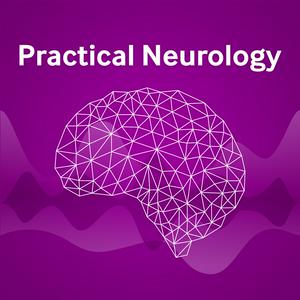
Obtenha o aplicativo gratuito radio.net
- Guardar rádios e podcasts favoritos
- Transmissão via Wi-Fi ou Bluetooth
- Carplay & Android Audo compatìvel
- E ainda mais funções
Obtenha o aplicativo gratuito radio.net
- Guardar rádios e podcasts favoritos
- Transmissão via Wi-Fi ou Bluetooth
- Carplay & Android Audo compatìvel
- E ainda mais funções


Practical Neurology Podcast
baixe o aplicativo,
ouça.





